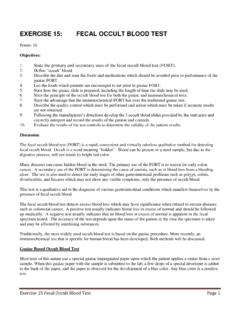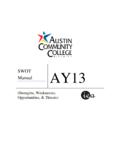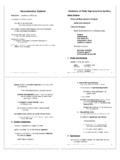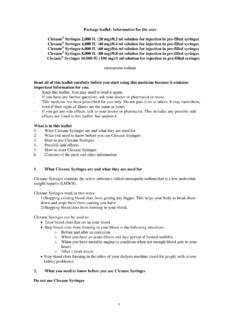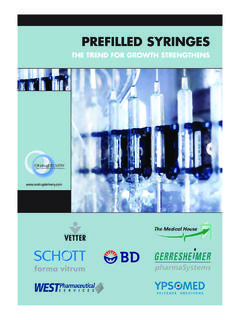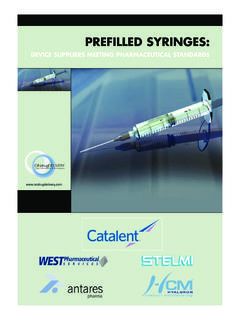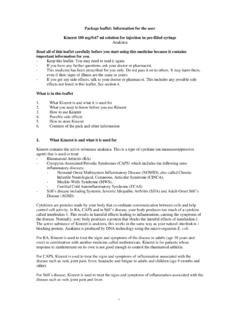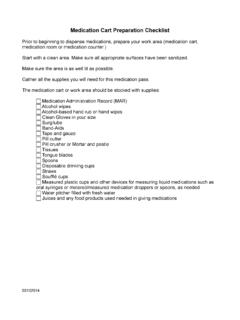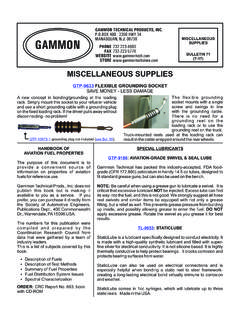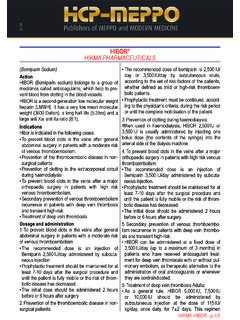Transcription of References Drawing Venous Blood With Syringes
1 Drawing Venous Blood with Syringes :A Risky Use of Injection EquipmentBy Janine Jagger, , , and Ginger Parker, NEEDLES USED FOR BLOODDRAWING have long been rec-ognized as presenting a high riskof bloodborne pathogen trans-mission following needlestickinjuries. Among 46 health careworkers with documented, occu-pationally acquired HIV, 20 cases(43%) were associated withinjuries from Blood Drawing needles. Conversely, needles usedfor intramuscular and subcuta-neous injections were associatedwith only one case (2%) of occu-pational HIV infection1, despitethe fact that injections are admin-istered much more frequentlythan Blood is drawn. While theaverage transmission rate follow-ing percutaneous exposure toHIV has been estimated at .3%2,an Italian study of 1,610 HIV-exposed health care workersshowed a .55% (2/365) transmis-sion rate for exposures involvingbloodfilled needles, and no transmissions (0/840) from expo-sures involving non- Blood filled Syringes areunique among sharp medicaldevices in that they are multi-pur-pose.
2 Their most common use isfor subcutaneous or intramuscu-lar injection of medication. Theyare also used as tools for manipu-lating body fluid specimens inclinical laboratories and for mixing drugs in the their most hazardoususes, however, is Venous blooddrawing. In 1998, the nationalEPINet database, including 52hospitals, showed disposablesyringes to be the device causingthe most reported percutaneousinjuries, accounting for 30%(950/3,180) of all reportedinjuries. It also showed that 19%(179/950) of syringe injuriesinvolved Syringes that had beenused for Venous Blood are unique, therefore, inthat they can be associated withinjuries having either the lowestor the highest risk of bloodbornepathogen transmission, depend-ing on the purpose for which theyare Blood Drawing is aprocedure for which a variety ofdevices are used.
3 Figure 1showsthat there were 548 injuries relat-ed to Venous Blood Drawing inthe national EPINet database in1998. Of those, 38% were associ-ated with winged steel needles,31% with vacuum tube phleboto-my devices, and 25% with disposable Syringes . These datashow that Drawing Venous bloodwith disposable Syringes remainsa common practice that results ina significant number of needle-sticks. injuries during Venous blooddrawing procedures. Unfor-tunately, safety Syringes areunlikely to reduce the hazards ofvenous Blood Drawing . Their usefor this purpose defeats the bene-fit of the safety design. Since theprotective feature can only be putin place after the Blood has beeninjected from the syringe into aspecimen container, the user hasalready been exposed to the additional risks described withconventional Syringes before thesafety feature can be 4also shows that bothconventional and safety syringescaused injuries when they wereinappropriately used for injec-tions into intravenous ports andfor intravenous flushes, both procedures for which needles arenot necessary.
4 In fact, of injuries from conventionalsyringes and of injuriesfrom safety-engineered syringeswere associated with inappropri-ate uses of a syringe. These find-ings emphasize the need for edu-cation in limiting the use of injec-tion equipment, whether conven-tional or safety-engineered, toappropriate applications. In con-clusion, the practice of drawingvenous Blood into syringesshould be reduced to a that draw Blood directlyinto vacuum tubes or other speci-men containers should be prefer-entially employed. The needleend of the Blood - Drawing deviceshould have an integrated safetyfeature such as a needle-shieldingor blunting feature. Such deviceshave been shown to reduce injuryrates from phlebotomy devices by25% to 76% in a CDC study4. Ifthere is no other alternative tosyringes for Venous Blood draw-ing in specific clinical situations,then large-volume Syringes with a sliding shield should beemployed.
5 The safety shieldshould have a larger diameterthan the vacuum tube into whichthe Blood will be injected. Thesafety shield should be locked inplace over the needle and the tubeinserted into the shield for theinjection of : For articles addressingadditional safety issues related toarterial Blood Drawing and capil-lary Blood sampling, refer to AEPvol. 1, no. 1 ( Report on BloodDrawing: Risky Procedures,Risky Devices, Risky Job ); AEPvol. 2, no. 1 ( EPINet DataReport: ABG Syringes AssociatedWith More Injuries DuringProcedure ); and AEP vol. 3, no. 5 ( Glass Capillary Tubes:Eliminating an Unnecessary Riskto Health Care Workers ). References 1. Advances in Exposure Preven-tion, 3:3 (1998), p. 33 (table).2. Henderson DK. HIV-1 in thehealth care setting. In: MandellGL, Bennett JE, Dolin R, and Practice ofInfectious Diseases.
6 New York,NY: Churchill Livingstone; 1995:2632-2656. 3. Ippolito G, Puro V, PetrosilloN, Pugliese G, Wispelwey B,Tereskerz PM, Bentley M, JaggerJ. Prevention, Management andChemoprophylaxis of Occu-pational Exposure to , VA: InternationalHealth Care Worker SafetyCenter, 1997, p. l3 [table 6].4. Centers for Disease Controland Prevention. Evaluation ofsafety devices for preventing percutaneous injuries amonghealth-care workers during phlebotomy procedures Minneapolis-St. Paul, New YorkCity, and San Francisco, 1993-1995. MMWR. 1997; 46; 21-2. BD, BD Logo and all other trademarks are the property of Becton, Dickinson and Company. in USA12/00VS58731 Becton DriveFranklin Lakes, NJ fromAdvances in Exposure Prevention vol. 5, no. 3, with 1 Since there are better alternatives, why do health careworkers use Syringes for venousblood Drawing ?
7 The reasons some cases, health care work-ers prefer to control the vacuumduring Blood Drawing if patientshave difficult veins. In manycases, it is just a question ofhabit; it is what the health careworker has always used or it wasthe device most readily availablewhen Blood Drawing needed to beperformed. with that choicecomes a particular set of 2compares the wayneedlesticks occur with syringesused for Venous Blood drawingversus Syringes used for intramus-cular or intravenous data highlight one of thespecific hazards caused by draw-ing Blood into Syringes : therequirement of transferring theblood from the syringe into aspecimen container. The figureshows that injuries resulting frompulling a needle out of a resistantsubstance such as rubber areuniquely associated with drawingblood into Syringes .
8 Once bloodis drawn into a syringe it is ofteninjected into a vacuum tubethrough its rubber stopper. (SeeFigure 3.) This involves an addi-tional manipulation of the needlewith an extra set of risks. First,the needle must not miss the rubber stopper, which is a narrowtarget. If it misses, it is likely tostick the hand holding the even if the needle is insertedinto the tube without incidentthere remains another risky hur-dle: it must be removed. Pulling aneedle from a resistant substancecan result in a rebound needle-stick, when the needle suddenlydisengages and the hand holdingthe needle lurches forward in areflex motion and sticks theopposing hand with the adverse event can occurif the injection of Blood into thetube overcomes the vacuum. Thestopper can pop off and splashthe worker with with needles aresometimes inappropriately usedto draw Blood from rubber portson intravenous or arterial the problem arises ofpulling the needle out of the portagainst resistance and risking a rebound needlestick.
9 Also,there is the additional exposurerisk of transferring Blood to aspecimen container. Another riskthat is unique to Drawing bloodinto Syringes is that of accidentalblood injections. These rare inci-dents inoculate health care work-ers with much larger quantities ofblood than needlesticks. Somedocumented cases of occupation-al transmission of HIV were theresult of accidental Blood injec-tions. In one case, a syringe full ofblood was left on a table. Ahealth care worker inadvertentlybacked into the table, pushingagainst the syringe. The syringewas pushed back against a rigidsurface which caused the plungerto depress, injecting the healthcare worker with Blood . Thistype of incident, which can onlyhappen with Syringes , carries amuch higher risk of pathogentransmission. A recent twist on the inap-propriate use of Syringes is theuse of safety-engineered Syringes ( with shielding or retracting features) for Venous Blood draw-ing.
10 Figure 4shows that bothconventional Syringes and safetysyringes were associated with1. Health care workers are defined as persons (including students 8 trainees) having worked in a health care, clinical, or HIV lab setting at any time since Health care workers who had a documented HIV seroconversion after occupational exposure or had other laboratory evidence of occupational infection: 47 had percutaneousexposures, 5 had mucocutaneous exposures, 2 had both types, and 1 had an unknown route of exposure. Fifty exposures were to Blood from an HIV-infected person, 1 to visiblybloody fluid, 1 to an unspecified fluid, and 3 to concentrated virus in a laboratory. Twenty-five of these health care workers developed Health care workers in this category have been investigated and are without identifiable behavioral or transfusion risks; each reported percutaneous or mucocutaneous occupa-tional exposures to Blood or body fluids, or laboratory solutions containing HIV, but HIV seroconversion specifically resulting from an occupational exposure was not 233558 Laboratory technician, clinical 161733 Physician, nonsurgical 61218 Health aide/attendant 11516 Housekeeper/maintenance worker 21214 Emergency medical technician/paramedic 01212 Technician/therapist (other than surgical/dialysis/RT)


